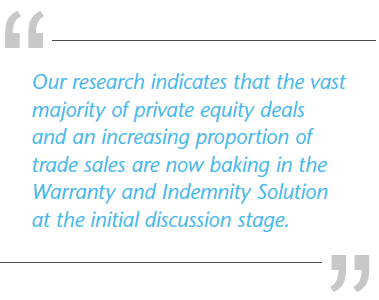
Overcoming Risk Roadblock in Deals: Pulling the Transaction Liability Solutions Lever
By Sharad Vishvanath and Jennifer Richards
When an organization pursues a merger and/or acquisition (M&A) transaction, the euphoria of the deal and the need for speedy action can take hold, resulting all too frequently in risks being under evaluated, or worse, being overlooked entirely.
Once identified, these transactional risks and liabilities may pose roadblocks to the smooth and successful completion of the deal or even prevent a deal from proceeding. Transactional risks emanate from multiple sources and often center around hidden or unknown issues such as inadequate disclosure or undisclosed losses or liabilities. Then again, transactional risks can stem from currently existing, known exposures, such as pending or threatened litigation, tax liabilities, environmental issues or other contingent liabilities. Both known and unknown risks create uncertainty in the purchase price and can impede, or prevent, successful negotiation of an M&A transaction. A question often asked by clients is “Can we transfer such risks out of our purview, and if so, what’s the value of such a solution?” The answer to this query lies in the various Transaction Liability Insurance Solutions that are available in the marketplace today. These include Warranty and Indemnity Insurance (W&I), Tax Liability Insurance, Litigation Buyout Insurance, and Contingent Liability Insurance. These various insurance solutions can assist in transferring transactional risks from the buyer or the seller to the insurance markets, by accessing the insurance markets as an alternative capital source to facilitate transactions.
What is W&I Insurance?
W&I insures either a buyer or a seller against losses arising from breaches of warranties or indemnity claims in respect of the target company or target assets that are the subject of the sale. This insurance based risk solution can be used by a seller to backstop the warranties and indemnities that it provides to the buyer (so called seller-side insurance) or it can be used by a buyer to replace or enhance a seller’s liability for warranties and indemnities (buyer-side insurance).
Key Features of Warranty and Indemnity Insurance
W&I insurance solutions offer the following advantages. They:
- Maximize distributable proceeds and optimize the value of the deal by reducing or eliminating the need to hold amounts in escrow or otherwise contingently reserved for claims;
- Enable a clean exit for a seller;
- Enhance the amount and period of recourse for the buyer;
- Facilitate transactions by breaking the impasse between the parties related to the post-closing indemnification scheme and specifying the amount of indemnity caps, thresholds, duration of warranties, etc.;
- Address collection concerns, e.g., acquisition from a distressed seller or receiver or a disparate group of individual sellers.
Other Transaction Liability Insurance Solutions
While W&I Insurance provides coverage for unknown risks arising from the representations and warranties provided in an M&A transaction, there is a suite of other transactional insurance products that are designed to address identified or ripened exposures. Insurance products can be utilized to insure the full range of liabilities that exist or may arise in the M&A context. These products enable the smooth completion of a transaction by removing the sticking points and transferring their associated risks to the insurance markets.
Case Study
Let’s examine how W&I insurance has been used as a risk solution to achieve a clean exit for the seller, while providing adequate post-closing indemnification for the buyer.
Issue
In a US$150 million sale of a Hong Kong-based portfolio company by a private equity seller, the buyer was looking for US$20 million escrow to respond to breaches of warranties and indemnities over a two-year survival period. However, the seller was looking to structure a clean exit and would only agree to a very limited escrow of US$1.5 million for 12 months. The parties could not reach agreement on these disparate terms.
Solution
A buyer-side W&I policy was implemented whereby the seller retained liability only for the limited escrow. The buyer supplemented this escrow with W&I insurance with a limit of liability of US$20 million and a survival period of two years for all warranties other than tax and title, which customarily survive for seven years.
Tax Liability Insurance. Tax Liability Insurance protects the parties against taxes (and associated defense costs) arising from identified tax exposures stemming from either the structure of the deal itself, or from the target company’s historical or current operations.
Litigation Buyout Insurance. Losses that may arise from existing or threatened litigation can be addressed by means of Litigation Buyout Insurance.
Contingent Liability Insurance. Other contingent liabilities that may arise or be identified in the M&A context, such as successor liability or regulatory concerns, can be dealt with via Contingent Liability Insurance.
Practicality: Are These Risks Real?
Our experience in working with a myriad of clients across many industries in the region indicates that such risks are not well understood, even though they are widespread in Asia Pacific. Despite the need for, and the availability of, risk transfer solutions to manage both known and unknown risks, awareness of these solutions is fairly low in the region (except in Australia).

We all know that in Asia there are many unascertained risks in target companies, especially for local-founder promoted companies that may not have the most sophisticated risk management systems. We frequently learn from our clients about experiences where they’ve had their fingers burned on prior deals.
In mature Asia Pacific markets like Australia, our research indicates that the vast majority of private equity deals and an increasing proportion of trade sales are now baking in the Warranty and Indemnity Solution at the initial discussion stage. Clearly, deal participants are seeing the value of employing transactional insurance as a deal facilitation and risk management tool. A large global IT major known for its highly acquisitive nature insists on getting additional W&I cover whenever dealing with the sellers of firms that are relatively immature in risk management.
Claims: Does the Solution Work?
Historical claims data shows that claims are in fact made with relative frequency and that valid claims have been paid out. If a claim is made on reasonable grounds with evidentiary proof, an insurer is required to act in good faith and handle the claim in a reasonable manner. If however the same claim was brought against the seller rather than an insurer, it might not necessarily be met with the same level of professionalism and care. The seller’s ability to pay out on the claim, especially when the escrow has already run its full course, is also not as certain as it would be with a well-capitalized insurance firm.
On balance, it is clear that there are convincing reasons for these solutions to be rapidly accepted as norms in managing the inherent risks in M&A transactions. The use of transactional insurance products allows sellers to structure clean, fast exits with limited post-closing contingent liabilities, while at the same time providing buyers with adequate protection and recourse to well-capitalized insurance companies. Our belief is that such solutions offer a significant first-mover advantage to clients who adopt them for their deals in Asia.
Authors
Jennifer Richards, Regional Director, Aon M&A Solutions ([email protected])
Sharad Vishvanath, Asia Pacific M&A Market Leader, Aon Mergers & Acquisition Solutions, Aon Hewitt ([email protected])
Get in touch
